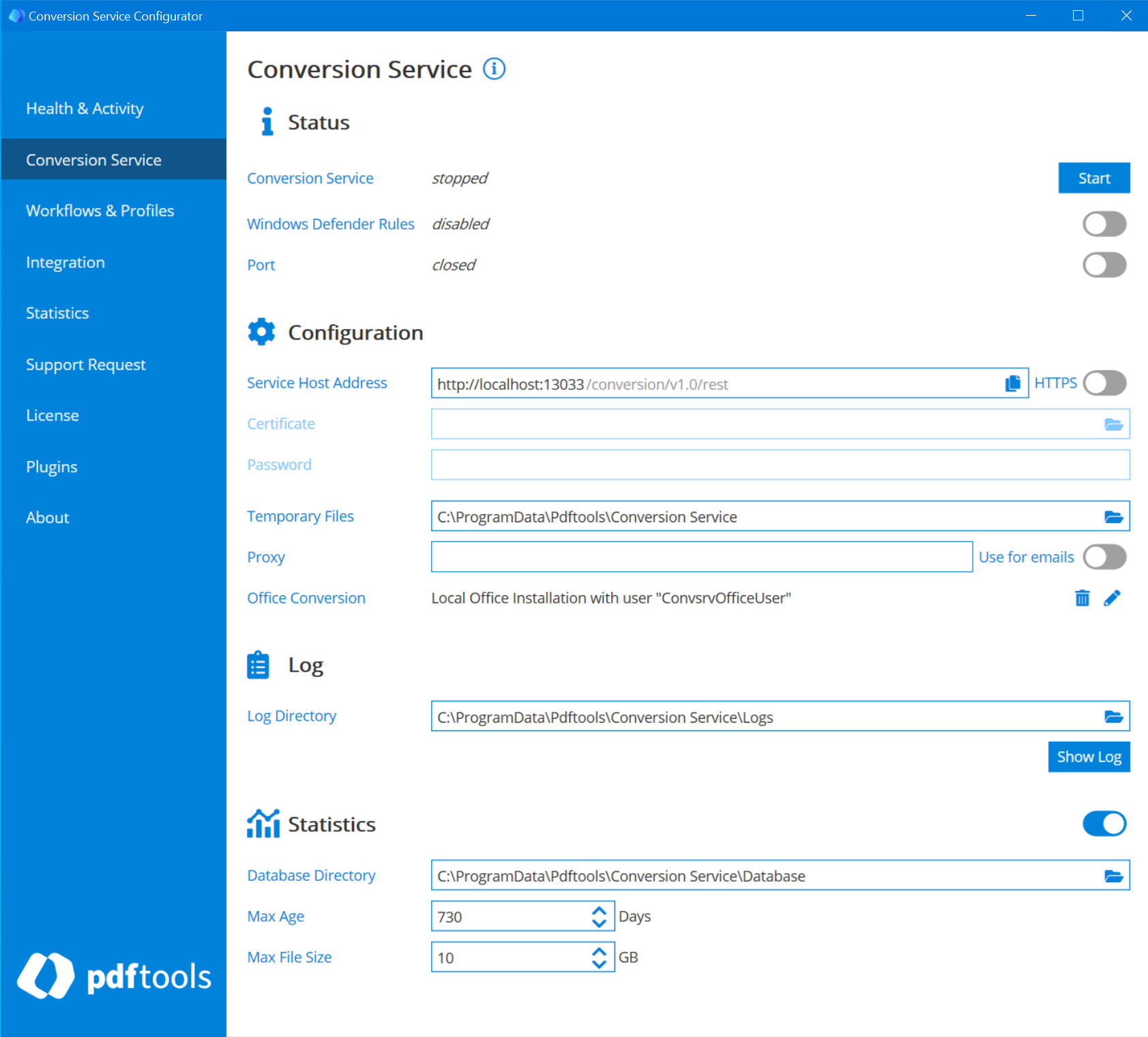Set up using the Configurator
You can configure the Windows service in the Conversion Service tab of the configurator.
You can view the status of the service, configure the host address and a proxy (if required), set the rules for Office conversion, determine the path to store temporay files and logs, and indicate a database where statistics on the service's performance can be stored.
To configure the service deployed in a Docker container, see Set up the service in your Docker container.

Status
Shows the status of the service and provides the controls to start, stop, and restart the service. The status is running when the Windows service is started and the configuration is valid. If the service is not operable even though the Windows service has been started, check the log file for more information on the cause. Common problems are a missing license or low disk space.
Whenever the configuration is changed, the Windows service must be restarted for the changes to take effect.
When the service is stopped, all current jobs are canceled and deleted.
The Windows service is installed with service name ConversionService and display name Conversion Service. Its status can also be changed using Windows' Services desktop app or the sc command line program.
Windows Defender Rules
Excludes the service processes and working directories from monitoring by the Windows Defender Antivirus. It is highly recommended that you enable this setting, because the service may be slowed down significantly otherwise.
Ports
Opens the port for connections from all other computers. The port configured in the Service Host Address section is by default available from the local machine only. If you want to access the service from other machines, e.g. using the shell client or the REST API, then you need to open a port in the Windows firewall.
If more specific rules are required, you need to create them manually (see API security)
Service host address
The address of the service host in the format http[s]://‹hostname›:‹port›/conversion/v1.0/rest. The default host address is http://localhost:13033/conversion/v1.0/rest
You should not change the address unless the default port 13033 is already in use on the local machine. If the port is changed and firewall rules have been added, they must be changed accordingly. You cannot configure the suffix conversion/v1.0/rest.
The configured service host address is also the endpoint URL used by the shell client and the REST API.
HTTPS
By default, the service endpoint uses HTTP. Activating HTTPS disables support for HTTP to prevent clients from accidentally sending sensitive information over HTTP.
HTTPS can be activated by setting the scheme of the service host address to https.
In addition, the following is required:
- A valid host certificate. The certificate must be provided as PKCS#12 file (
.pfxor.p12) that includes the certificate's private key and issuer certificates. If the private key is password protected, the password must be configured. - The host name. The
‹hostname›of the service host address must be set to the name of the host certificate.
Otherwise, clients such as the shell client refuse to connect. This hinders correct operation of many components, including the Configurator GUI or the Connection configuration. - A trusted host certificate.
Temporary Files
This is the directory where temporary files are written to. To optimize performance, this directory should be on a local drive with fast read and write access.
Proxy
Configuration of the proxy URL to be used for all HTTP and HTTPS communication to external hosts. The option can either be left empty for no proxy or must be a string with the following syntax: http[s]://[‹user›[:‹password›]@‹host›[:‹port›]
Where:
- http/https: Protocol for connection to proxy.
- ‹user›:‹password› (optional): Credentials for connection to proxy (basic authorization).
- ‹host›: Hostname of proxy.
- ‹port›: Port for connection to proxy.
Office conversion
Configure the service to convert Word, Excel and PowerPoint to PDF conversion. Click Configure. For more information, see Office conversion.
Log directory
The directory where all log files are written to. This includes the log files of the service (see Service log), the connectors, and the configurator.
Statistics
Configure whether the service stores service, job, and task information to a database file to analyze the conversion history with the Statistics tab. The location of the database is configured in the Database directory setting.
Database directory
The directory where the database is stored when the Statistics setting is enabled. This setting is only configurable when the Statistics setting is turned on.
Max. age
The configured maximum age of the datebase entries. Information of the conversion history will be deleted after reaching the maximum age. This setting is only configurable when the Statistics setting is turned on.
Max. file size
The configured maximum file size of the database. Older entries of the conversion history will be deleted if the maximum database file size is exceeded. This setting is only configurable when the Statistics setting is turned on.